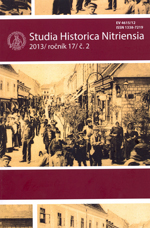Studia Historica Nitriensia, 2013, roč. 17, č. 2:
Obsah/Contents/Inhalt
Štúdie a články/Articles/Studien
Authors: Mitáš Vladimír – Furmánek Václav
Author: Bartl Július
Title: Mestá a mestečká Nitrianskej župy v stredoveku
Author: Janura Tomáš
Title: História Čachtického hradu od jeho počiatkov po obdobie rozpadu na zrúcaninu
Author: Nemeš Jaroslav
Title: Uhorsko v 16. storočí: prísahy vernosti a poslušnosti cirkevných osôb
Author: Šmíd Marek
Title: Apoštolská nunciatura v Praze v meziválečném období
Author: Vrbata Aleš
Materiály/Materials/Materialien
Author: Palárik Miroslav
Title: První část návrhu museologie pro venkovská musea a návrh směrnic pro národopis v musejních sbírkách
Author: Eliašová Silvia
Author: Prelovská Daniela
Title: Sonda do propagácie slovenských múzeí v prvej polovici 70. rokov 20. storočia
Rozhľady/Horizons/Horizonte
Author: Jakubej Ján
Title: Andreas Osiander starší – jeden z teoretikov reformácie
Author: Gogová Stanislava
Title: Archeológia v systéme muzeologických disciplín
Author: Šteiner Pavol
Title: Rumunský 2. tankový pluk v prvej fáze Bratislavsko-brnianskej operácie
Diskusia/Discussion/Diskussion
Author: Hečková Janka
Title: Problematika výučby pravekých dejín
Author: Kičková Adriana
Title: Ženy v učebniciach dejepisu
Author: Otčenášová Slávka
Title: Možnosti rozvíjania kritického zmýšľania študentov prostredníctvom vyučovania dejepisu
Author: Palárik Miroslav
Title: Aplikácia regionálnych dejín do školskej praxe prostredníctvom realizácie projektu Mesto pod mestom
Author: Hudák Peter
Title: Aplikácia poznatkov o lokálnej podobe holokaustu vo výchovno-vzdelávacom procese
Author: Župčán Ladislav
Title: Perspektívy začlenenia historickej architektúry do vyučovacieho procesu
Author: Župčánová Martina
Title: Nové možnosti prezentácie regionálnych dejín v priestoroch múzeí
Recenzie a anotácie/Review and Annotations/Kritik und glossen
KAČÍREK, Ľuboš – RAGAČ, Radoslav – TIŠLIAR, Pavol. Múzeum a historické vedy. (Miroslav Glejtek)
ČAJKA, František. Církevněslovanská legenda o svaté Anastázii. (Martina Chromá)
KOVAŘÍK, Jiří. Ludvík XIV. Život, doba a války krále Slunce. (Ľudovít Marci)
LE GOFF, Jacques. Svatý Ludvík. (Ľudovít Marci)
SLOBODNÍK, Martin. Politické, náboženské a ekonomické aspekty čínsko-tibetských vzťahov v 14. – 15. storočí. (Beáta Pintérová)
MICHLOVÁ, Marie. Protentokrát aneb česká každodennost 1939-1945. (Nina Sozanská)
ŠIDLÍKOVÁ, Zuzana. Móda na Slovensku v medzivojnovom období (1918-1939). (Nina Sozanská)
Kronika/Chronicle/Chronik
